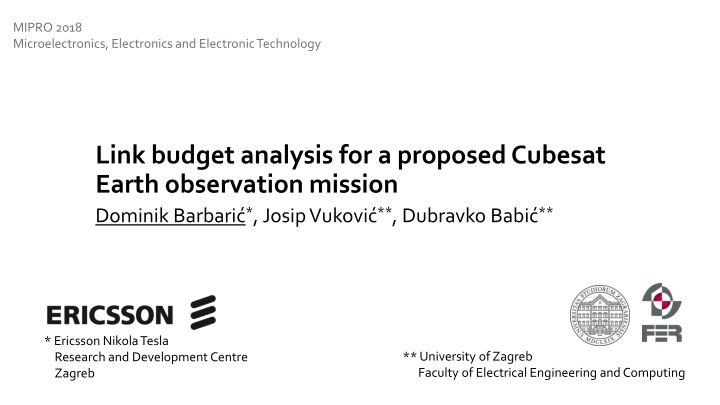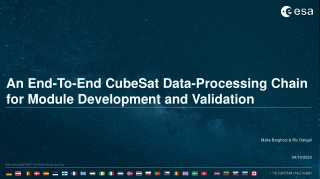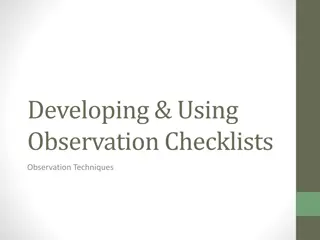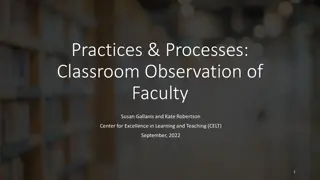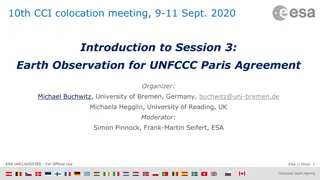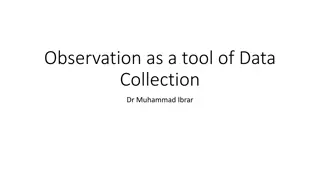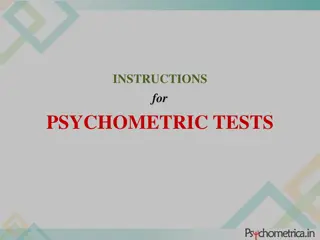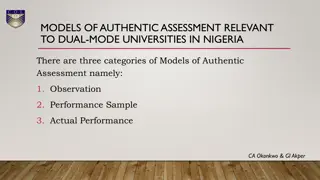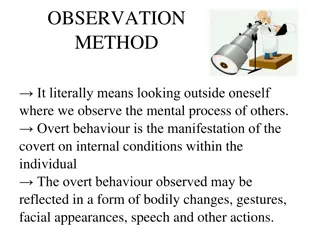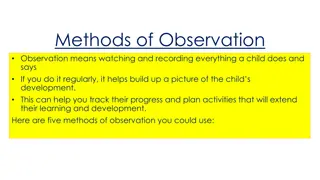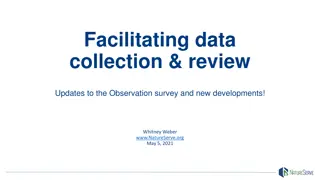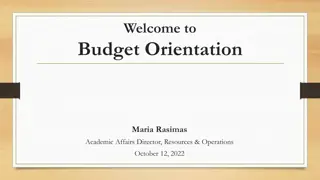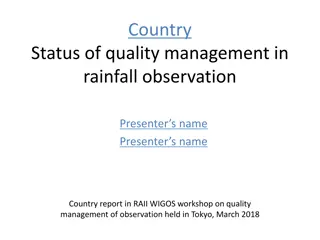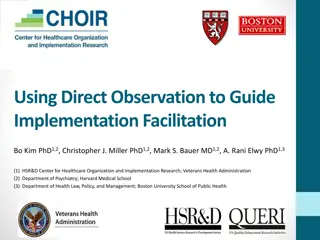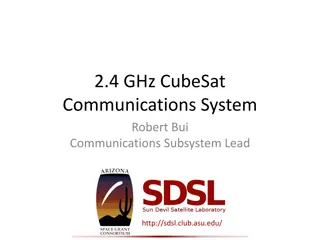Link Budget Analysis for Cubesat Earth Observation Mission
This research paper discusses the link budget analysis for a proposed Cubesat Earth observation mission, covering aspects such as Cubesat dimensions, mission objectives, communication parameters, orbital mechanics, and current missions in various frequency bands. Key topics include mapping light pollution, measuring RF noise, and satellite communication reliability during visibility periods. The paper also explores orbital mechanics related to Low Earth Orbits and satellite visibility characteristics.
Download Presentation

Please find below an Image/Link to download the presentation.
The content on the website is provided AS IS for your information and personal use only. It may not be sold, licensed, or shared on other websites without obtaining consent from the author.If you encounter any issues during the download, it is possible that the publisher has removed the file from their server.
You are allowed to download the files provided on this website for personal or commercial use, subject to the condition that they are used lawfully. All files are the property of their respective owners.
The content on the website is provided AS IS for your information and personal use only. It may not be sold, licensed, or shared on other websites without obtaining consent from the author.
E N D
Presentation Transcript
MIPRO 2018 Microelectronics, Electronics and Electronic Technology Link budget analysis for a proposed Cubesat Earth observation mission Dominik Barbari *, Josip Vukovi **, Dubravko Babi ** * Ericsson Nikola Tesla Research and Development Centre Zagreb ** University ofZagreb Faculty of ElectricalEngineering andComputing
What is a Cubesat? Dimensions 10 cm x 10 cm x 10 cm Weight up to 1.33 kg Stacks of 1U units 25.5.2018. Barbari , Vukovi , Babi Link budget analysis for a proposed Cubesat Earth observation mission 2
What is our mission? Mapping light pollution Mapping Earth s magnetic field Measuring RF noise in selected bands Testing new types of photodetectors Throughput requirements Satellite stores and processes data Long periods of communication loss Reliable link in times of satellite visibility 25.5.2018. Barbari , Vukovi , Babi Link budget analysis for a proposed Cubesat Earth observation mission 3
Current missions Frequency bands Amateur bands VHF UHF S-band Licensed bands S-band Communication standards AX.25 HAM adaptation of X.25 BPSK modulation Full duplex 9600 bit/s Proprietary QPSK modulation Full duplex 3.4 Mbit/s 144 MHz 146 MHz 430 MHz 440 MHz 2300 MHz 2450 MHz 2000 MHz 2300 MHz 25.5.2018. Barbari , Vukovi , Babi Link budget analysis for a proposed Cubesat Earth observation mission 4
Communication parameters Either VHF/UHF duplexing, or proprietary S-band Bit error rate requirement 10-5 Required bandwidth andSNR VHF / UHF S-band 20 kHz 2.95 MHz 6.4 dB 10.2 dB 25.5.2018. Barbari , Vukovi , Babi Link budget analysis for a proposed Cubesat Earth observation mission 5
Orbital mechanics Cubesatsoccupy Low Earth Orbits (LEO) 400 km 600 km above mean sea level Defined orbit ?= 6971 km(600 km AMSL) Inclination 50 Orbital period 96.5 min Satellite visible 12 times a day 8 to 12 minutes of uninterrupted communication Figure 1: 3D view of the defined orbit 25.5.2018. Barbari , Vukovi , Babi Link budget analysis for a proposed Cubesat Earth observation mission 6
Orbital mechanics Figure 2: Satellite footprint animation 25.5.2018. Barbari , Vukovi , Babi Link budget analysis for a proposed Cubesat Earth observation mission 7
Ground station constraints Minimum elevation angle ? = 20 Farthest position from ground station defines maximum losses ?= 600 km ? = 1392 km Figure 3: Satellite position geometry 25.5.2018. Barbari , Vukovi , Babi Link budget analysis for a proposed Cubesat Earth observation mission 8
Propagation effects Free space loss Major attenuation in satellite communications Frequency dependent Table 1: Free space loss Frequency Free space loss 2 4?? ? 146 MHz 138.6 dB ???= 446 MHz 148.3dB 2200 MHz 162.2 dB 25.5.2018. Barbari , Vukovi , Babi Link budget analysis for a proposed Cubesat Earth observation mission 9
Propagation effects Rain attenuation Rain penalty is estimated by requiring that the rain-induced attenuation will not surpass the highest value expected during a certain percentage of time in one year. Typical constraint: A 99.99% annual link availability ??= 0.09 ?? 25.5.2018. Barbari , Vukovi , Babi Link budget analysis for a proposed Cubesat Earth observation mission 10
Propagation effects Cross polarization effects Rotation of polarization Strong frequency dependence Mitigated by use of circular polarization Other effects Ionospheric scintillation Doppler shift 25.5.2018. Barbari , Vukovi , Babi Link budget analysis for a proposed Cubesat Earth observation mission 11
Antennas Table 2: Groundantenna Ground station antenna Parabolic Diameter 5 m Half-power beamwidth Frequency Gain 28.8 146 MHz 14.7 dBi 9.4 446 MHz 24.3dBi 1.9 2200 MHz 38.2 dBi Depointing losses Significant for 2200 MHz ??= 1.2 ?? 25.5.2018. Barbari , Vukovi , Babi Link budget analysis for a proposed Cubesat Earth observation mission 12
Antennas Satellite-side antennas VHF / UHF double dipole set Enable circular polarization Low directivity (cca. 0 dBd) S-band patch antenna Occupies one satellite side Higher gain 8.3 dBi 25.5.2018. Barbari , Vukovi , Babi Link budget analysis for a proposed Cubesat Earth observation mission 13
Antennas Satellite-side antennas Depointing loss Significant, due to antennas radiation profile Satellite always facing Earth orthogonally Table 3: Satellite depointing loss Half-power beamwidth Depointing penalty Frequency 80 146 MHz 6 dB 80 446 MHz 6 dB 71 2200 MHz 9 dB 25.5.2018. Barbari , Vukovi , Babi Link budget analysis for a proposed Cubesat Earth observation mission 14
Transceivers Ground station Levels up to 100 W at RF port Widely available transceivers Satellite-side Limited power budget Levels up to 2 W at RF port Highly sensitive receivers As high as -121 dBm 25.5.2018. Barbari , Vukovi , Babi Link budget analysis for a proposed Cubesat Earth observation mission 15
Noise Generally calculated by ? = ????? The area viewed by the receiving antenna determines ??? Satellite-side Standard Earth surface temperature ???= 290 K 25.5.2018. Barbari , Vukovi , Babi Link budget analysis for a proposed Cubesat Earth observation mission 16
Noise Ground station Highly dependent on Frequency Polarization Othercelestialobjects Sun Moon Ionosphere Antenna radiation profile Pointingerror Receivingamplifier etc 25.5.2018. Barbari , Vukovi , Babi Link budget analysis for a proposed Cubesat Earth observation mission 17
Noise Ground station Considering partialSun visibility Including a 6 dB link budget margin Table 4: Equivalent noise tempertures Frequency Noise temperature 146 MHz 100 K 446 MHz 130 K 2200 MHz 2000 K 25.5.2018. Barbari , Vukovi , Babi Link budget analysis for a proposed Cubesat Earth observation mission 18
Link budget Table 5: Link budget Frequency Direction Noise level Signal level Link Budget Uplink -131.0 dBm -77.8 dBm 40.8 dB 146 MHz Downlink -122.6 dBm -97.7 dBm 12.5 dB Uplink -131.0 dBm -77.9 dBm 40.7 dB 446 MHz Downlink -132.6 dBm -97.8 dBm 22.4 dB Uplink -109.3 dBm -76.7 dBm 16.4 dB 2200 MHz Downlink -112.8 dBm -95.7 dBm 0.9 dB 25.5.2018. Barbari , Vukovi , Babi Link budget analysis for a proposed Cubesat Earth observation mission 19
Summary Defined requirements for the satellite communication link Reviewed atmospheric effects for frequency bands of interest Reviewed expected noise issues for the communication link Identified issues for all system components Excessive losses Mechanical challenges 25.5.2018. Barbari , Vukovi , Babi Link budget analysis for a proposed Cubesat Earth observation mission 20
Conclusion Link budget is met with a wide margin 2 GHz range shown to be a good communication window Low rain attenuation Good noise performance High throughput Presented valid communication parameters for a sustainable link 25.5.2018. Barbari , Vukovi , Babi Link budget analysis for a proposed Cubesat Earth observation mission 21
Thank you Q&A Link budget analysis for a proposed Cubesat Earth observation mission dominik.barbaric@ericsson.com www.ericsson.hr www.fer.unizg.hr/zrk
Noise Figure: Celestial radio noise sources 25.5.2018. Barbari , Vukovi , Babi Link budget analysis for a proposed Cubesat Earth observation mission 23
Propagation effects Rain attenuation Geographical area Frequency Polarization Mean annual 0 isotherm height Figure 4: Rain attenuation nomogram 25.5.2018. Barbari , Vukovi , Babi Link budget analysis for a proposed Cubesat Earth observation mission 24
